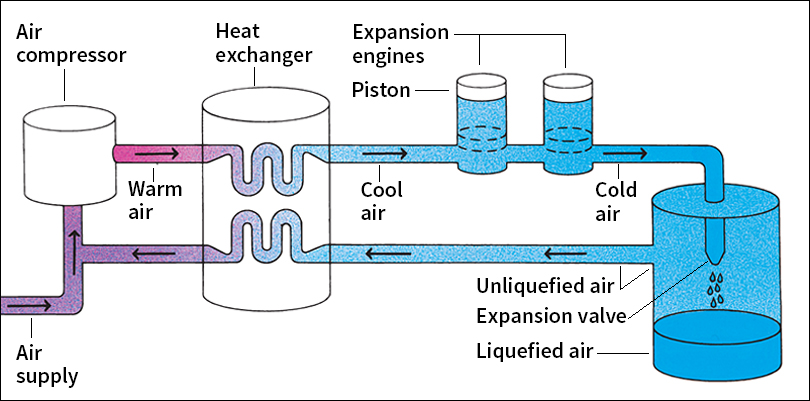Cryogenics << `kry` uh JEHN ihks >> is the study of extremely low temperatures. It includes the development of techniques that produce and maintain such temperatures for industrial and scientific use. Temperatures of primary interest in cryogenics range from about -184 °F (–120 °C) to almost absolute zero, –459.67 °F (–273.15 °C). Absolute zero is, theoretically, the lowest temperature a gas can reach. Cryogenic temperatures are usually given on the Kelvin scale, the standard for scientific temperature measurement. Absolute zero has a value of zero on the Kelvin scale.
The word cryogenics comes from two Greek words meaning cold and produce. Physicists first produced extremely low temperatures in the 1870’s with the development of liquid air (see Liquid air).

In 2003, scientists at the Massachusetts Institute of Technology (MIT) cooled atoms of the element sodium to 0.00000000045 K, one-half of one-billionth of a Celsius degree above absolute zero. The scientists used a combination of laser and magnetic techniques to cool the atoms. The atoms changed their state from a gas to a form of matter known as a Bose-Einstein condensate (see Matter (States of matter)).
The first industrial use of cryogenics was the production of liquid air, a primary source of liquid oxygen and liquid nitrogen. Most hospitals now use liquid oxygen as a source of gaseous oxygen for breathing. Certain aircraft and spacecraft carry liquid oxygen that can be converted into gaseous form for crews to breathe on long flights. Other uses of liquid oxygen include the manufacture of synthetic gases and the treatment of waste water. Liquid oxygen and liquid hydrogen are also used in some rocket propellants and in fuel cells. Liquid nitrogen serves as a refrigerant. In addition, industry uses cryogenic techniques in the liquidizing, transportation, and storage of natural gas and the freezing, transportation, and storage of food.
Cryogenics has provided physicians with ways to freeze living parts of the body, such as blood and eye corneas, for future use. Other medical uses of cryogenic techniques include the freezing of organs during surgery and the destruction of cancerous tumors and other diseased tissues. Most of these applications use liquid nitrogen (see Cryobiology).
In physics research, the development of the liquid hydrogen bubble chamber provided a major tool for the study of subatomic particles. Processing at cryogenic temperatures has made isotope-separation techniques more efficient for nuclear energy research. Cryogenics also contributed to the discovery of superconductivity, the ability of some materials to conduct electric current at extremely low temperatures. Superconducting magnets cooled with liquid helium are used in medicine in magnetic resonance imaging (MRI), a technique that produces images of the internal organs of the body (see Magnetic resonance imaging). Superconductors are also used in large electric motors and generators.
See also Absolute zero; Refrigeration (Low-temperature refrigeration); Superconductivity.
